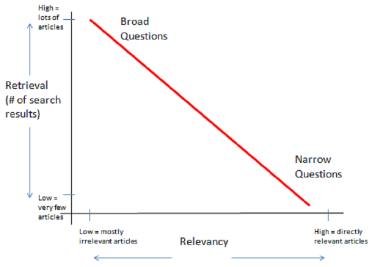1. Identify a research question.
For example: "Does the use of warfarin in elderly patients recovering from
myocardial infarction help prevent stroke?"
Ask a clear, answerable
question.
2. Consider which databases
might provide information for your topic. Often
PubMed
or Web of
Science will cover a wide spectrum of biomedical issues. However,
other
databases and grey literature
sources may specialize in certain disciplines.
Embase is
generally comprehensive but also specializes in pharmacological interventions
and even lesser-known databases such as Alt
HealthWatch (EBSCO) can be good sources for alternative
medicine. Literature
Search: Where to Start Searching for Information
3. Select the major subjects or ideas from
your question. Focus in on the particular concepts involved in
your research. Then brainstorm synonyms and related terminology for these
topics. Selecting general or nonspecific terms will generate a long list of
studies, many of which may be unrelated to your study. More specific search
terms will result in a more effective and focused search strategy.

4. Build your search using boolean
operators. Combine the synonyms in your database using boolean
operators such as AND or OR. Sometimes it is necessary to research parts of a
question rather than the whole. So you might link searches for things like the
preventive effects of anticoagulants with stroke or embolism, then AND
these results with the therapy for patients with cardiovascular disease.
("Anticoagulants"[Mesh] AND ("Stroke"[Mesh] OR "Embolism"[Mesh]) AND
"prevention and control" [Subheading]) AND "Cardiovascular
Diseases/therapy"[Mesh]



5. Filter and save your search results. This
may be a short list because of your topic's limitations. You may have search
results for searches in more than one database. Make sure your list is saved or
archived and presents you with what's needed to access the full text.
6. Read the selected articles thoroughly and
evaluate them. Evaluate and synthesize the studies' findings and
conclusions.
Note the following:
- assumptions some or most researchers seem to
make
- methodologies, testing procedures, subjects,
material tested researchers use
- experts in the field: names/labs that are
frequently referenced
- conflicting theories, results, methodologies
- popularity of theories and how this has/has not
changed over time
7. Organize the selected papers by looking for
patterns and by developing subtopics.
Note the following:
- Findings that are common/contested
- Important trends in the research
- The most influential theories
8. Develop a thesis or purpose statement.
Write a one or two sentence statement summarizing the conclusion you have
reached about the major trends and developments you see in the research that
has been conducted on your subject.
9. Write the literature review. Begin by
summarizing why your research is important and explain why your approach will
help fill gaps in current knowledge. Then incorporate how the information
you've selected will help you to do this. You do not need to write about all of
the included research you've chosen, only the most pertienent. Structure your
sections by themes or subtopics, not by individual theorists or researchers. If
you find that each paragraph begins with a researcher's name, it might indicate
that, instead of evaluating and comparing the research literature from an
analytical point of view, you have simply described what research has been
done.
10. Review your work
- Look at the topic sentences of each paragraph. If
you were to read only these sentences, would you find that your paper presented
a clear position, logically developed, from beginning to end? The topic
sentences of each paragraph should indicate the main points of your literature
review.
- Make an outline of each section of the review and
decide whether you need to add information, to delete irrelevant information,
or to restructure sections.
- Read your work out loud. That way you will be
better able to identify where you need punctuation marks to signal pauses or
divisions within sentences, where you have made grammatical errors, or where
your sentences are unclear.
- Since the purpose of a literature review is to
demonstrate that the writer is familiar with the important professional
literature on the chosen subject, check to make certain that you have covered
all of the important, up-to-date, and pertinent texts. In the sciences and some
of the social sciences it is important that your literature be quite
recent.
- Make certain that all of the citations and
references are correct and that you are referencing in the appropriate style,
which will most likely be AMA Style.
- Check to make sure that you have not plagiarized
either by failing to cite a source of information, or by using words quoted
directly from a source.
- Text should be written in a clear and concise
academic style; it should not be descriptive in nature or use the language of
everyday speech.
- There should be no grammatical or spelling
errors.



